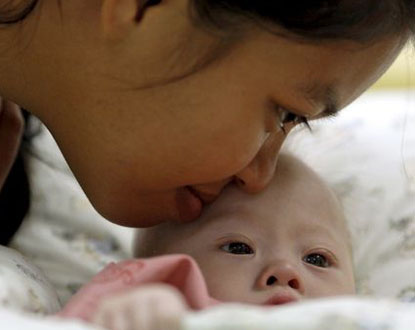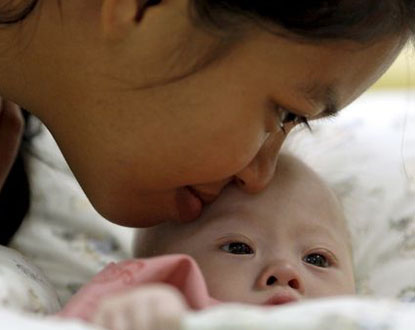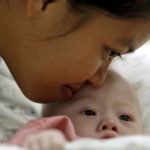On August 3, 2014, it was reported that an Australian couple had abandoned their newborn with Down syndrome. Born to a Thai surrogate mother, he and his twin sister Pipah—who is in good health—were allegedly abandoned deliberately by their parents, according to Pattaramon Chanbua, the surrogate mother. Fear of having to care for a disabled child? Fear of judgment from others? Lack of information about Down syndrome? Absence of financial support for parents of disabled children? Many such questions arise in an attempt to understand this act, which stirred international public opinion.

Concretely, what is Down syndrome?
Down syndrome (mongolism) is a genetic anomaly linked to the presence of three chromosome 21s instead of two. There are two other types of trisomy, 13 and 18, but these children are not viable.
This anomaly accounts for about one in 800 births.
Is there a screening for Down syndrome during pregnancy?
“In France, since the beginning of amniocentesis in the 1970s, doctors have continually sought to improve this screening. It is indeed necessary, for patients who wish it, to screen for as many affected children as possible without increasing the rate of fetal loss linked to invasive procedures: amniocentesis (amniotic fluid puncture) performed from the second trimester and chorionic villus sampling (sampling of trophoblast, future placenta) feasible at the end of the first trimester but more technical. These procedures are considered invasive as they have an estimated risk of 0.5 to 1% fetal loss.
At the start of fetal medicine, amniocentesis was offered to patients who had previously had an affected child, then to women over 38 years, and finally when there were ultrasound abnormalities. For about twenty years, the addition of serum markers has been available, a blood test performed during the second trimester, thus quite late.
Currently, how does this screening process work, and what does it involve?
For the past few years, the method of screening has changed. A risk calculation is offered to patients who desire it.
This screening is carried out at the end of the first trimester and takes into account the patient’s age, an ultrasound measuring the nuchal translucency of the baby, and a blood test measuring two proteins. If the risk exceeds 1/250, a chorionic villus sampling or amniocentesis is offered. Currently, we screen 80% of Down syndrome cases with less than 5% of invasive procedures.”
80%, a rather satisfactory result?
Yes, but paradoxically, we do not see a clear decrease in the births of children with Down syndrome.
This is probably due to the progressive increase in maternal age and because screening is not desired by all couples.
Another means of screening has been available in France since December 2013, which is the non-invasive test: it allows for the detection of trisomy through a simple maternal blood test. This test, a real alternative to invasive sampling, is not covered by social security and can only be offered to high-risk patients.
The idea of offering this DNA test to everyone would certainly strengthen our eugenic approach: it’s the near future.
Do you think that parents who accept or request this screening would want to terminate the pregnancy if it were positive?
In the vast majority of cases, when parents agree to conduct the screening, it is with the intention of terminating the pregnancy if the child is affected. However, a number of patients refuse to terminate their pregnancy for religious, ethical, or moral reasons, for example. Other patients still prefer to do the screening and sampling before diagnosis and prepare to have a different child.
In addition, since December, the private genetics laboratory CERBA offers non-invasive diagnostic procedures. This has existed in the United States for a long time and in Switzerland as well.
It consists of diagnosing the three main trisomies through a blood test. It replaces the amniocentesis done at the beginning of the fourth month. It’s a DNA test. It is only carried out after the ultrasound and blood test when a risk has already been detected. However, it is not covered by social security and costs 800 euros.
In the future, non-invasive diagnosis for all would prevent unnecessary miscarriages. Better still: gene therapy, but that is still far off!”
Thus, on one hand, screening seems efficient, even if efforts still need to be made in this area. On the other hand, several factors need to be considered: cultural, religious, medical, and financial factors often stand as barriers to more effective screening.
These cases of child abandonment are not exclusive to Australia. Isabelle Orsini, president of the Trisomy 21 association in Nice, recounts: “We had two abandoned children with Down syndrome. These two children were adopted by a family. They are now 20 years old.
There must obviously be other cases that we are not necessarily aware of at the association. It is difficult to know why we see such cases.
When a child with Down syndrome is abandoned, there is a tendency to think it’s because of their disability. It might be due to the fear or panic of the parents. But we cannot know the actual reasons, other family-specific factors certainly come into play,” asserts Isabelle Orsini.
“In our association, we rely on common laws to help our children, such as the right to attend school. We have 26 employees, not all full-time, and a few volunteers, including parents who volunteer their time to the association.
In 2003, we opened an SESAD, a home education, care, and support service. Currently, this service follows 40 children.
In 2011, a social-medical accompaniment service (SASMA) was implemented for disabled adults to follow youngsters over 20 years. There are 26 young people followed by this service. In these two services, we work with doctors, nurses, special educators, psychomotor therapists, occupational therapists, and psychologists,” details the association president.
The association’s goal is to support adults in their life projects and children in their educational projects, from school to high school. “The older ones are assisted in view of professional integration. We also help them to be independent and have their own apartment. This involves them knowing how to manage their shopping, budget, and prepare a meal,” she explains.
“When supporting a person in their life project, it includes family. One of our philosophies is the triple partnership. We work in collaboration with the person, professionals, and parents. As partners, we are constantly seeking better ideas or means to achieve this collaboration and make it evolve. It’s important,” she adds.
Finally, it should not be forgotten that every person is different. All have different skills and potential. Some are more academic than others, for example. Consequently, the support is completely individualized. We talk about the person’s life project. Our goal is for these people to live well through a number of activities, be it leisure, applied arts, or academic activities,” highlights Isabelle Orsini.



